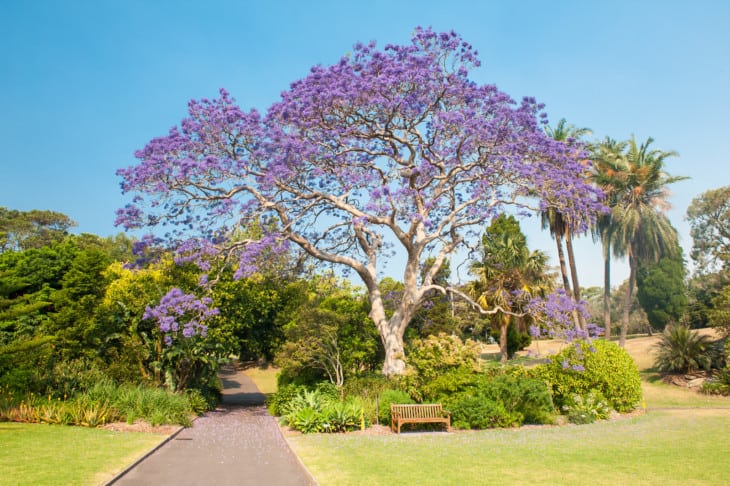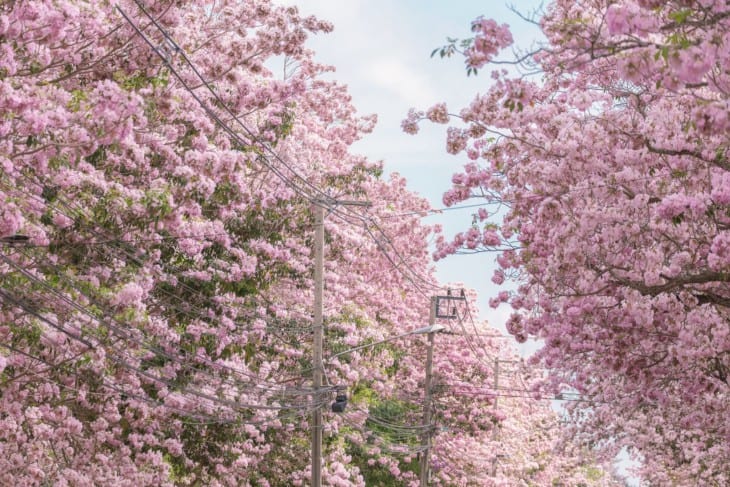Are you looking for the best flowering trees to plant in Arizona? Since the Copper State has a dry, hot climate, you need to find drought and heat-tolerant blossoming trees that can thrive in such weather conditions. Read on to discover the ideal flowering trees in Arizona that you can plant in your garden!
Contents
- 1. Southern Magnolia
- 2. Crape Myrtle
- 3. Tipu Tree
- 4. Palo Verde
- 5. Jacaranda
- 6. Yellow Oleander
- 7. Flowering Plum
- 8. Coral Gum Eucalyptus
- 9. Barbara Karst Bougainvillea
- 10. White Orchid Tree
- 11. Desert Willow
- 12. Weeping Bottlebrush
- 13. Texas Olive
- 14. Texas Mountain Laurel
- 15. Pink Trumpet Tree
- 16. Fragrant Mimosa
- 17. Chaste Tree
- 18. Red Hibiscus
- 19. Chitalpa
- 20. Bailey Acacia
- 21. Plumeria Tree
Even though Arizona is considered to be a desert state since it houses four North American deserts, including the Great Basin, the state has a much more diverse landscape than one might think. The Grand Canyon State is divided into three significant and diverse geographic regions – the Transition Zone, the Colorado Plateau, and the Basin and Ridge Region.
The state of Arizona is nothing less than a land of contradictions. It consists of a hot low-elevation desert covered with creosote bushes and cacti, as well as the largest stand of evergreen ponderosa pine trees in the world. Half of the state is decked with desert, while the other half is lined with mountain ranges, plateaus, and forests of spruce, pine, and fir.
Moreover, the climate experience throughout the state is also diverse. Arizona’s southern half experiences an arid, desert climate with sweltering summers and mild winters, while its northern half experiences semi-arid and semi-arid, humid climate with hot, humid summers and better winters. Mostly, a large part of the state experience sunny, dry weather throughout the year. Winters are mild at best, while spring and fall are warm.
Give its mostly hot climate, Arizona is home to some of the hardiest, drought-resistant trees in the US, including the Tipu Tree, Coral Gum Eucalyptus, Crape Myrtle, Palo Verde, White Orchid Tree, Desert Willow, and Fragrant Mimosa, several types of palm trees, among many others. If you plant these and other such flowering trees in your home garden in Arizona, you can benefit from their exquisite beauty during the flowering season, enjoy their changing fall foliage, and welcome the visitors that their blooms and fruits will undoubtedly attract.
Here are some of the most beautiful flowering trees in Arizona!
1. Southern Magnolia
- Magnolia grandiflora
- Flowering in: Spring to early Summer
- Height: 37 ft
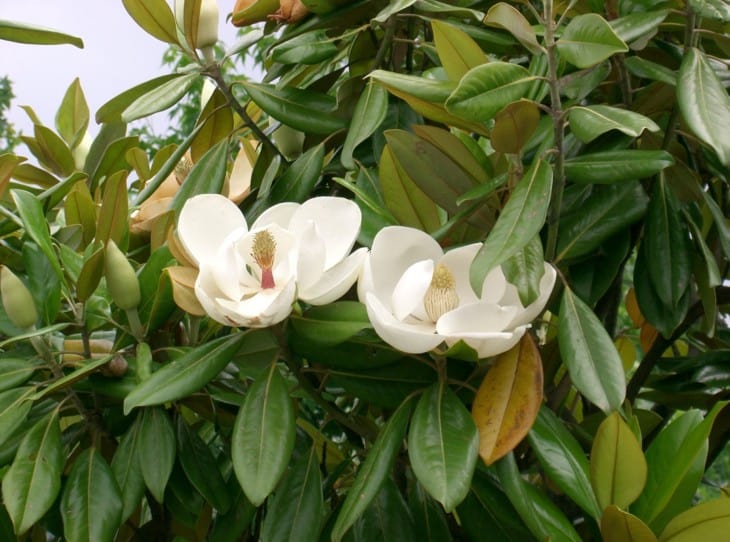
Grown popularly across the US, Southern Magnolia Trees are medium-sized ornamental specimens native to the country. These flowering trees grow cup-shaped, creamy-white, massive, fragrant flowers that blossom on their dense crown. They feature a sturdy stem and branches that are decked with dark green, leathery, evergreen leaves with rusty brown undersides. Southern Magnolia Trees need to grow in well-drained, rich medium moist soils and sunlit or partially shaded locations to thrive.
2. Crape Myrtle
- Lagerstroemia
- Flowering in: Summer and Spring
- Height: 35 ft
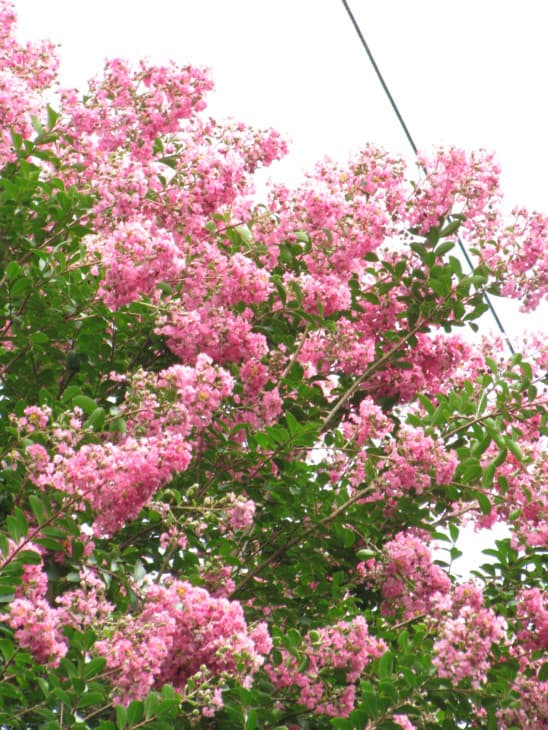
Crape Myrtle is a medium-sized flowering specimen native to parts of Korea and China. Commonly known as “lilac of the South,” Crape Myrtle trees feature an upright, vase-like crown that is adorned with lush, deciduous, ovate, dark green leaves that develop yellow, orange, and red hues in autumn. These trees produce purplish-pink, long-lasting blossoms that grow in massive clusters. Crape Myrtle is a drought-tolerant tree that grows well in sun-kissed locations and well-drained, moist soils.
3. Tipu Tree
- Tipuana tipu
- Flowering in: Spring
- Height: 20-50 ft
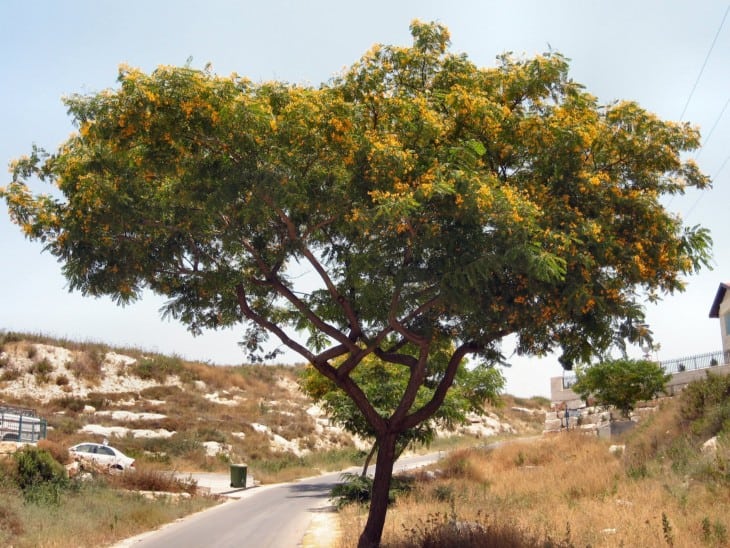
Tipu Trees are fast-growing, small-sized, semi-evergreen, tropical Bolivian natives. They feature a high, spreading canopy and a single trunk. They produce pea-shaped, apricot or yellow-hued flowers. They also bear large, brown-hued seed pods. These trees feature compound, pinnate, oval, green leaves. Tipu Trees are drought-resistant trees that need to grow in sunlit or partially shaded locations and acidic, well-drained, clay, loamy, or sandy soils to thrive.
4. Palo Verde
- Cercidium ’desert museum’
- Flowering in: Spring
- Height: 20-35 ft
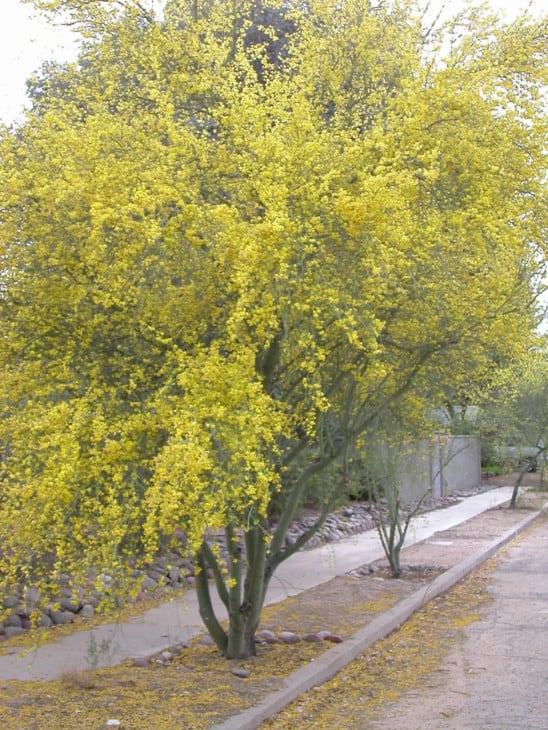
Palo Verde is typically grown in the desert areas of southern California. Palo Verde Trees are small-sized flowering specimens with a conspicuously smooth, green bark and intricately growing branches. These trees feature deciduous, compound, tiny leaves and clusters of bright yellow blossom. They also bear bean-like pods. Palo Verde is a drought-tolerant tree that thrives in sun-kissed areas and well-drained, slightly sandy soils.
5. Jacaranda
- Jacaranda mimosifolia
- Flowering in: Spring and Summer
- Height: 60 ft
Jacaranda is a truly magnificent, fast-growing flowering, tall-sized flowering specimen native to Argentina, Bolivia, and Brazil. Jacaranda Trees have a rounded, spreading crown that is adorned with large, soft, fern-like, divided, bright green leaves. These trees produce striking, eight inches-long, pyramid-shaped clusters of blue-lavender, trumpet-shaped blossoms with distinctive white throats. These trees grow well in sun-kissed areas and well-drained, sandy, moist, fertile soils.
6. Yellow Oleander
- Cascabela thevetia
- Flowering in: Spring to Fall
- Height: 8-12 ft
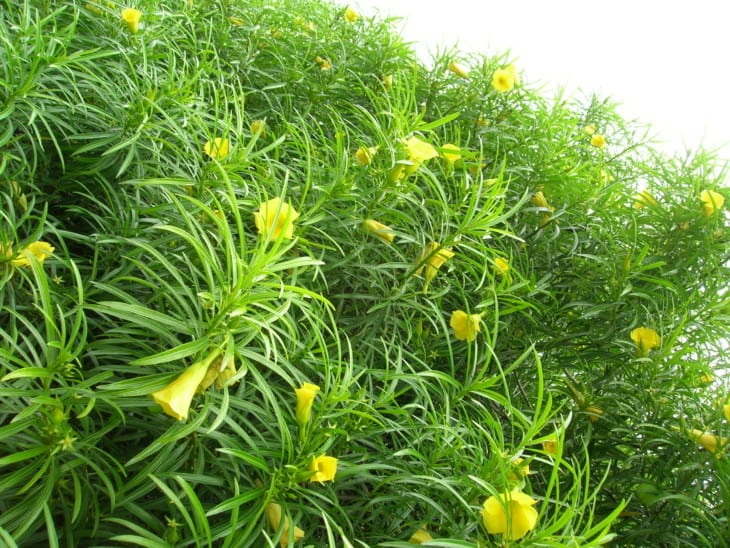
Native to the West Indies, Belize, southern Mexico and Central, and South America, Yellow Oleander is a tropical evergreen shrub with yellow blossoms and alternate leaves. It’s an upright shrub with linear-lanceolate, willow-like, glossy green leaves and large, funnel-shaped, somewhat fragrant, yellow blossoms that grown in terminal clusters. It also bears black seed pods. Yellow Oleander Trees thrive in medium moist, rich, sandy soils and sunlit or partially shaded locations.
7. Flowering Plum
- Prunus triloba
- Flowering in: Spring
- Height: 10-20 ft
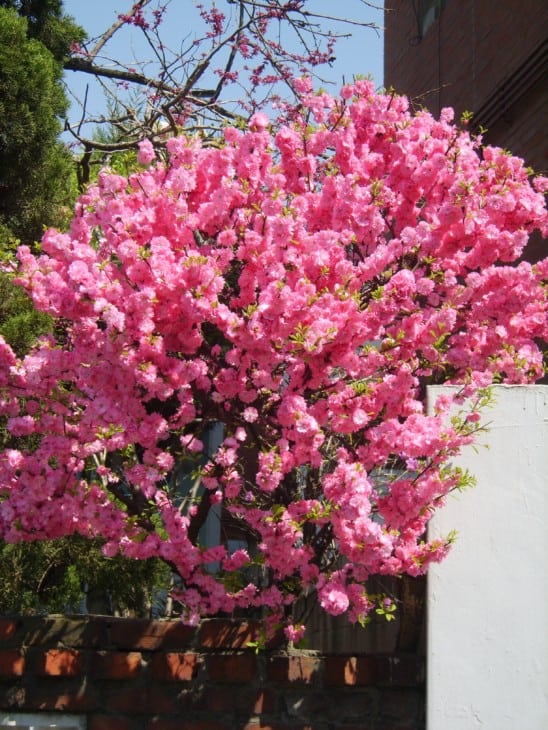
Flowering Plum Trees are small-sized flowering specimens native to China. These trees are popularly grown as multi-stemmed, rounded shrubs or understory blossoming trees. They feature coarse, double-toothed, three-lobed, medium-green, broad-ovate, dense leaves that develop a yellow hue in fall. They also yield profuse, pink-hued, 5-petaled blossoms that give way to globose, red fruits. Flowering Plum Trees need to grow in sunlit or speckled areas and well-drained, moist, fertile soils to thrive.
8. Coral Gum Eucalyptus
- Eucalyptus torquata
- Flowering in: Summer
- Height: 13-36 ft
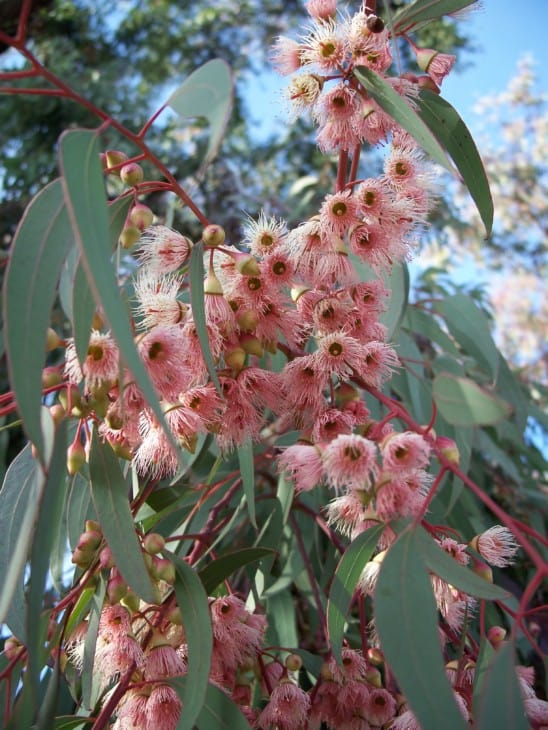
Coral Gum Eucalyptus is a small-sized, low-maintenance, drought-resistant flowering specimen with a columnar crown and block or scaly, red-brown bark. This tree grows well in sandy, clay soils and well-drained, dry loams and full sun. It bears purple and red capsules and intricately textured white, cream, red, or pink-hued blossoms. It also features fragrant, evergreen, light green-colored, lanceolate leaves.
9. Barbara Karst Bougainvillea
- Bougainvillea ‘barbara karst’
- Flowering in: Late Fall to Spring
- Height: 20-30 ft
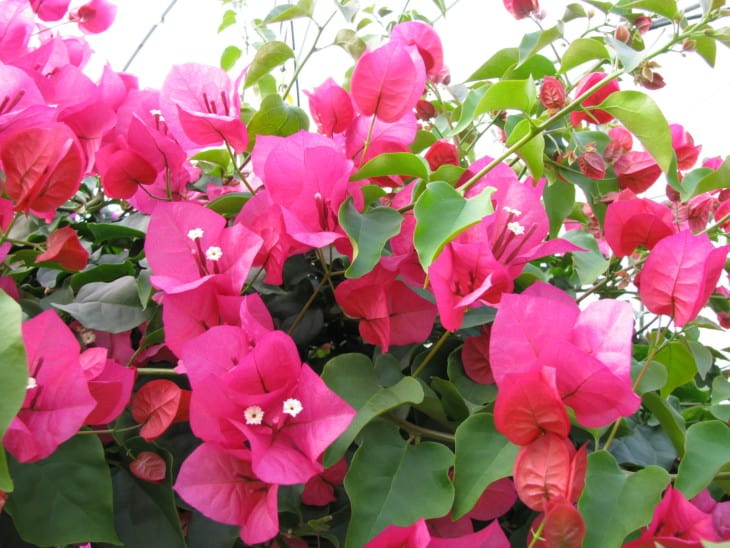
Barbara Karst Bougainvillea is a Bougainvillea hybrid. It’s a free-flowering, evergreen shrub that you can grow as a climbing vine with adequate support. This vigorous flowering specimen features showy, bright, magenta-red, papery, petal-like bracts that surround tiny, white blossoms. It’s ideally grown over patios. This blossoming shrub also features dull, ovate, wavy-edged, green leaves. This drought-tolerant tree grows well in full sun and acidic, well-drained soils.
10. White Orchid Tree
- Orchidaceae
- Flowering in: Fall
- Height: 25-30 ft
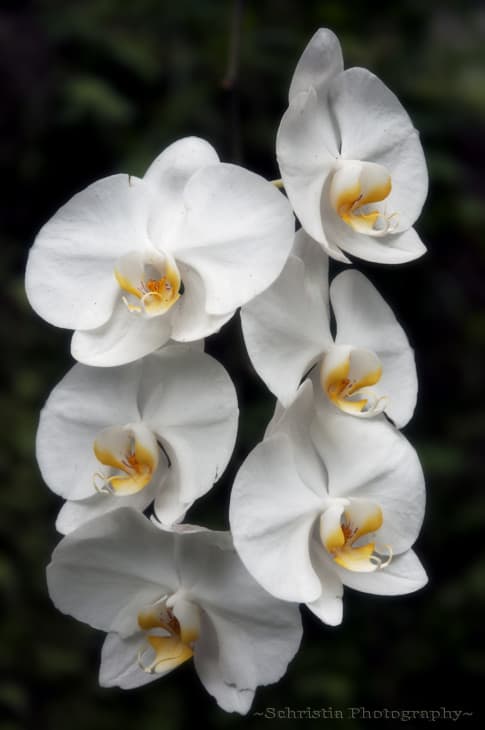
White Orchid Trees are hardy, small to medium-sized trees, semi-evergreen or deciduous flowering trees. They feature an often-leaning trunk, twisting, ascending branches with drooping edges, and large, bi-lobed, dark green leaves. With maturity, these trees develop a uniform and symmetrical crown. They produce attractive, white-hued, wide, orchid-like blossoms that are followed by flat, dark brown seed pods. They have a stunning vase-shaped form. These drought-tolerant trees thrive in full sun or partially shaded areas and well-drained, acidic clay or loamy soils.
11. Desert Willow
- Chilopsis linearis
- Flowering in: Summer
- Height: 15-30 ft
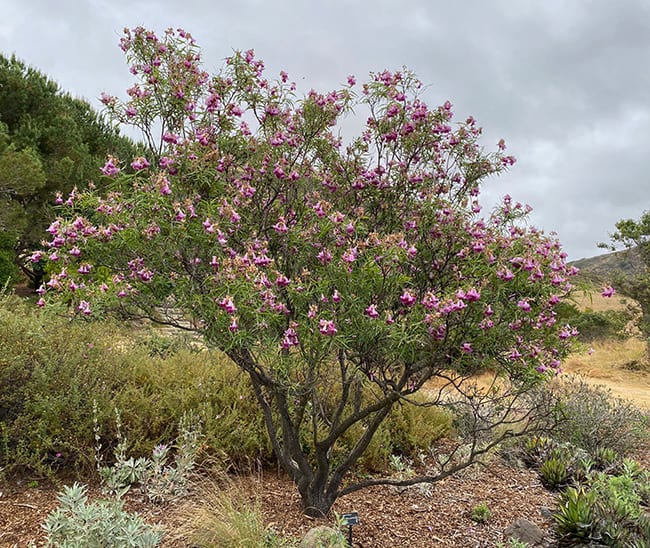
Popularly grown in the country, Desert Willow Trees are Northern US natives. They are small-sized flowering specimens loved for their rapid growth. These trees feature a twisted trunk, deciduous green foliage, and slender twigs. They grow 5-petaled, purple or dark pink-hued, exotic blossoms. Their distinctive blooms have yellow and white strikes that run through their centers. Dessert Willow Trees are drought-tolerant specimens that grow well in sunlit locations and well-drained soils.
12. Weeping Bottlebrush
- Melaleuca viminalis
- Flowering in: Spring to Fall
- Height: 20 ft
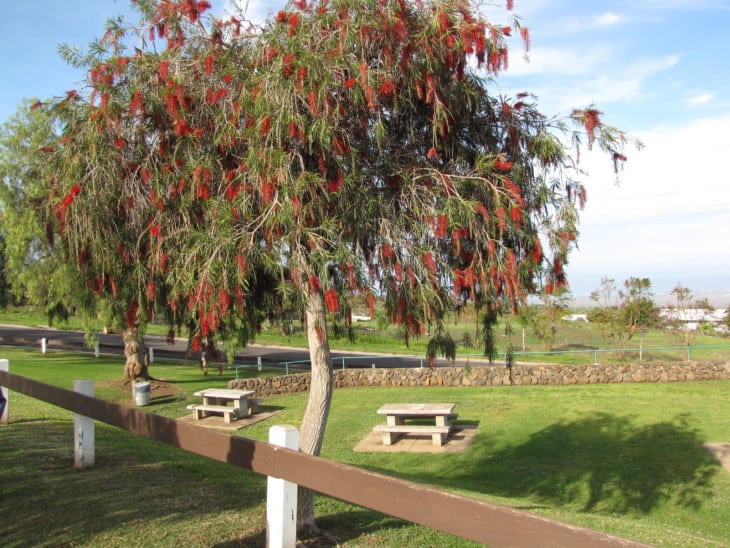
Weeping Bottlebrush is a small-sized, fast-growing tree that you can also grow as a shrub. It features pendulous branches decorated with light green, narrow leaves. This tree also produces large, 6-inches long, spike-like clusters of bright red-blood blossoms that resemble bottlebrushes. The flowers attract bees and hummingbirds. Weeping Bottlebrush Trees thrive in sunlit or partially shaded locations and well-drained, moist, acidic soils.
13. Texas Olive
- Cordia boissieri
- Flowering in: Spring to Summer
- Height: 25-30 ft
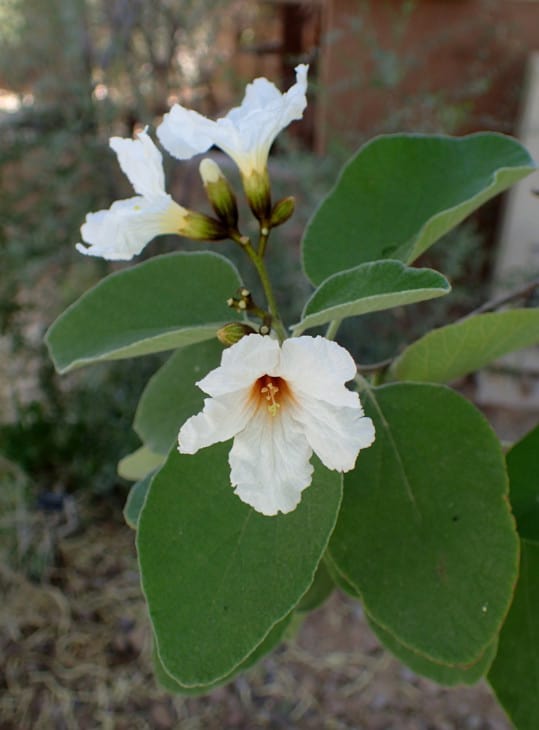
Also known as Mexican Olive, Texas Olive Trees are small to medium-sized, ornamental specimens with a sinuous trunk. These trees feature soft, evergreen, large, gray-green, ovate leaves. They also produce large, white-hued, trumpet-shaped blossoms with a crepe paper-like texture and distinctive yellow throats. Texas Olive Trees are drought-tolerant trees that grow well in a wide variety of well-drained soils and sun-kissed or speckled locations.
14. Texas Mountain Laurel
- Sophora secundiflora
- Flowering in: Early Spring
- Height: 10-15 ft
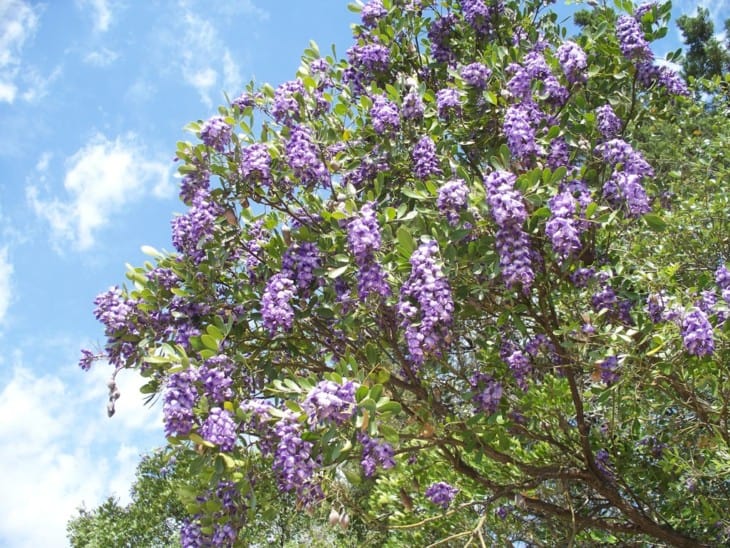
Texas Mountain Laurel Trees are slow-growing, small-sized flowering specimens. These evergreen, multi-trunked trees feature handsome, glossy, dense, compound, dark green leaves. They also produce showy, long-lasting, bluish-lavender, fragrant blossoms that grow in drooping clusters. They bear semi-woody pods with toxic, bright red seeds. Texas Mountain Laurel is a drought-tolerant tree that needs well-drained, rocky, dry, calcareous soils and sunlit or partially shaded areas to thrive.
15. Pink Trumpet Tree
- Tabebuia rosea
- Flowering in: Spring
- Height: 20-40 ft
Native to Mexico, northern Venezuela, Central America, Equador, and Colombia, Pink Trumpet Trees are small to medium-sized flowering specimens. Also known as Pink Poui, Pink Trumpet Trees are evergreen with long, smooth trunks and a rounded, spreading crown. They produce showy, trumpet-shaped, and white to purplish-pink blossoms with distinctive yellow throats. The blooms grow in profuse clusters and are followed by bean-like pods. The trees also feature palmate leaves with five leathery, elliptic to elliptic-oblong, scaly, toothless, medium to dark green lefts. These trees grow best in sun-kissed areas and well-drained, moist, fertile, deep soils.
16. Fragrant Mimosa
- Mimosa borealis
- Flowering in: Spring to Summer
- Height: 20-40 ft
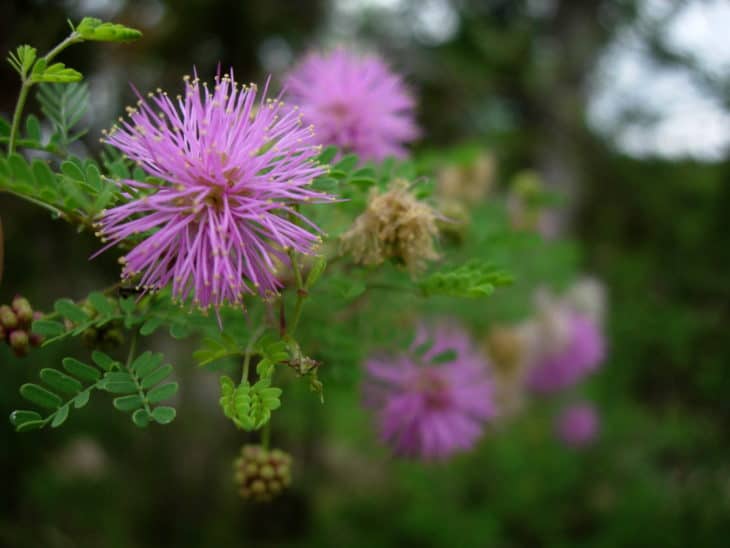
Also known as Catclaw Mimosa, Fragrant Mimosa Trees are small to medium-sized, intricately-branched, slender, rounded, deciduous shrub. They produce attractive, fragrant, pink-hued, globe-like flowers that grow in ball-shaped, dense clusters. They also feature delicately bipinnate leaves that grow on their zigzagging, rigid branches. Fragrant Mimosa is a drought-tolerant accent tree that thrives in acidic or slightly alkaline soils and full sun.
Related: Mimosa benefits and drawbacks
17. Chaste Tree
- Vitex agnus-castus
- Flowering in: Late Spring, Summer, and Early Fall
- Height: 15 ft
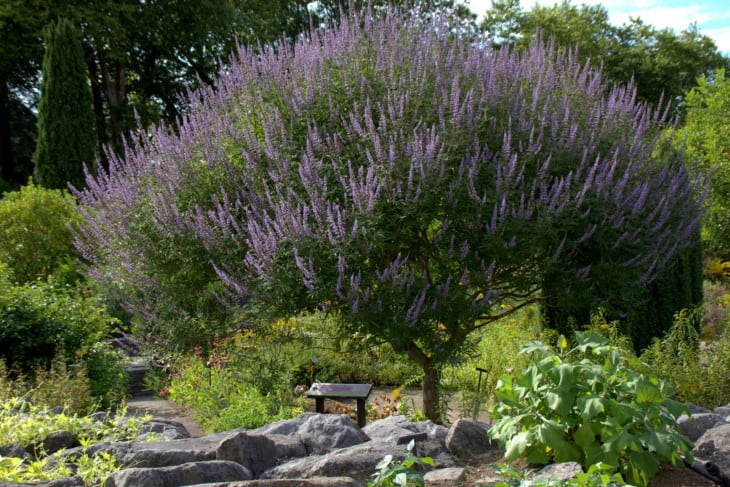
Chaste Trees are small-sized, multi-trunked flowering specimens that produce spike-shaped, upright, large clusters of lavender-colored, butterfly- and hummingbird-attracting blossoms. These attractive blossoming trees are native to southern Europe and central Asia. They feature fragrant green leaves that are separated into five to seven narrow leaflets. Chaste Trees need moist, well-drained soils and ample sunlight to thrive.
18. Red Hibiscus
- Hibiscus rosa-sinensis
- Flowering in: Summer
- Height: 3-7 ft
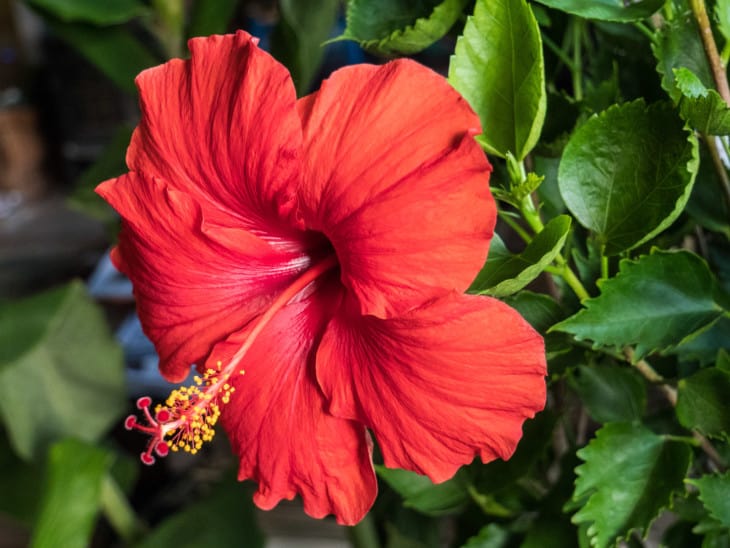
Red Hibiscus Trees are loved for their stunning tropical beauty. Originating in the Pacific Islands and Asia, Red Hibiscus produces large, exotic, yellow-hued blossoms that can grow in small clusters or individually. Each bloom has a distinctive reddish pink center and a spiny pollen-clad yellow tube that runs through its center. These flowers attract hummingbirds and butterflies. Red Hibiscus grows well in sun-kissed areas and well-drained, moist, slightly acidic soils.
Related: Are Hibiscus Plants Poisonous?
19. Chitalpa
- Chitalpa tashkentensis
- Flowering in: Summer
- Height: 20-30 ft
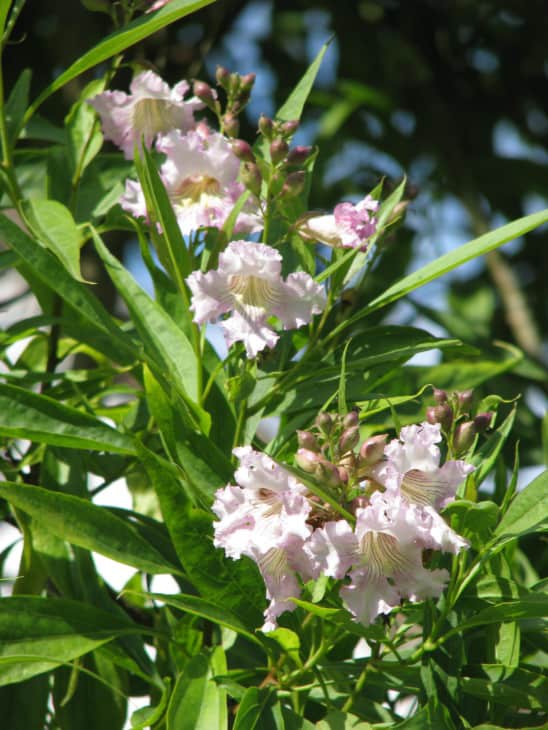
Chitalpa Trees are rapid-growing, deciduous flowering specimens with a dense, oval, spreading crown. These trees are an inter-generic hybrid between the Southern Catalpa trees and the Desert willow Trees. They feature dull green lanceolate leaves with fuzzy undersides and tapering ends. They produce bell-shaped, catalpa-like, pink to white blossoms that grow in upright racemes. Chitalpa Trees thrive in moderately fertile, deep, medium moist, well-drained soils and sunlit or speckled locations.
20. Bailey Acacia
- Acacia baileyana
- Flowering in: Spring
- Height: 20-30 ft
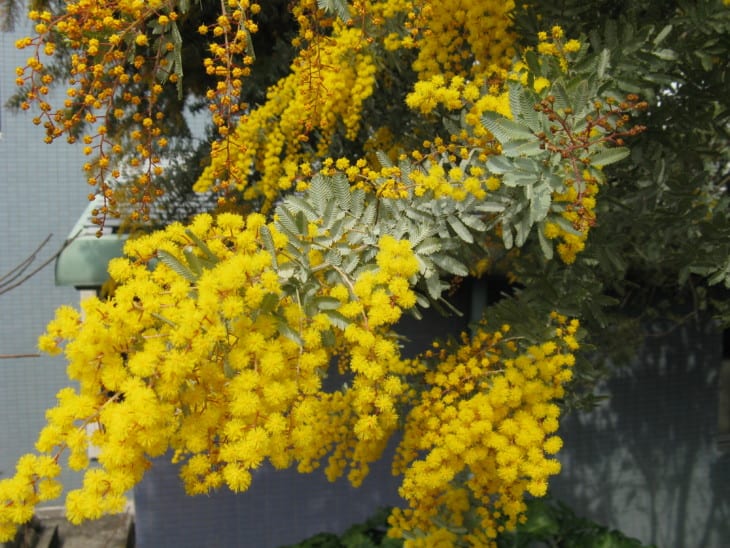
Native to New South Wales, Australia, Bailey Acacia Trees are fast-growing, large, evergreen shrub that you can also grow as a small tree. They feature a wide-spreading canopy and weeping branches adorned with finely-cut, feathery, blue-gray leaves. They produce clouds of small, rounded, bright golden yellow flowers that grow in axillary racemes. Bailey Acacia Trees grow well in sunlit areas and well-drained, neutral to acidic, moist soils.
21. Plumeria Tree
- Plumeria rubra
- Flowering in: Late Spring, Summer, and Fall
- Height: 25 ft
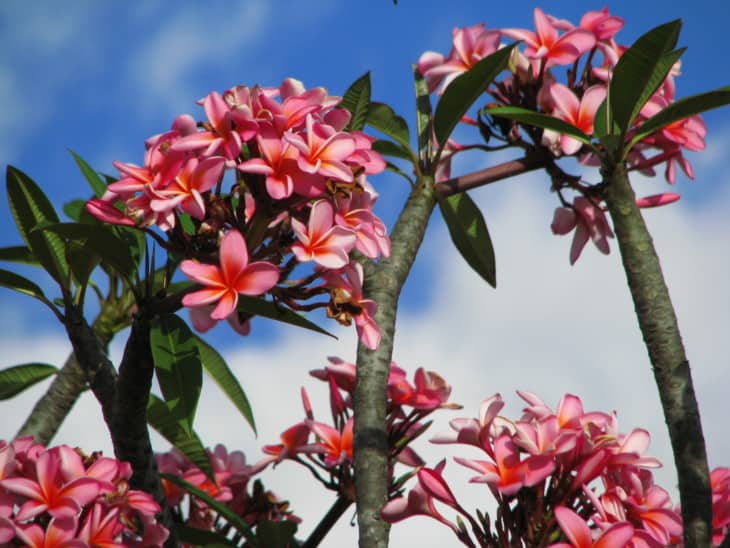
Also known as Nosegay Trees, Plumeria Trees are small-sized, deciduous flowering specimens with a rounded, vase-shaped crown and fleshy branches. Native to the hot, dry parts of Venezuela, Mexico, and Central America, and certain tropical regions across the world, these trees produce intensely aromatic, pink to red-hued, 5-petaled blossoms. The flowers grow in terminal clusters at the branch tips. These trees have dark green, elliptic leaves with undulated margins. Plumeria Trees need well-drained, rich, dry to medium moist loans and ample sun to thrive.


